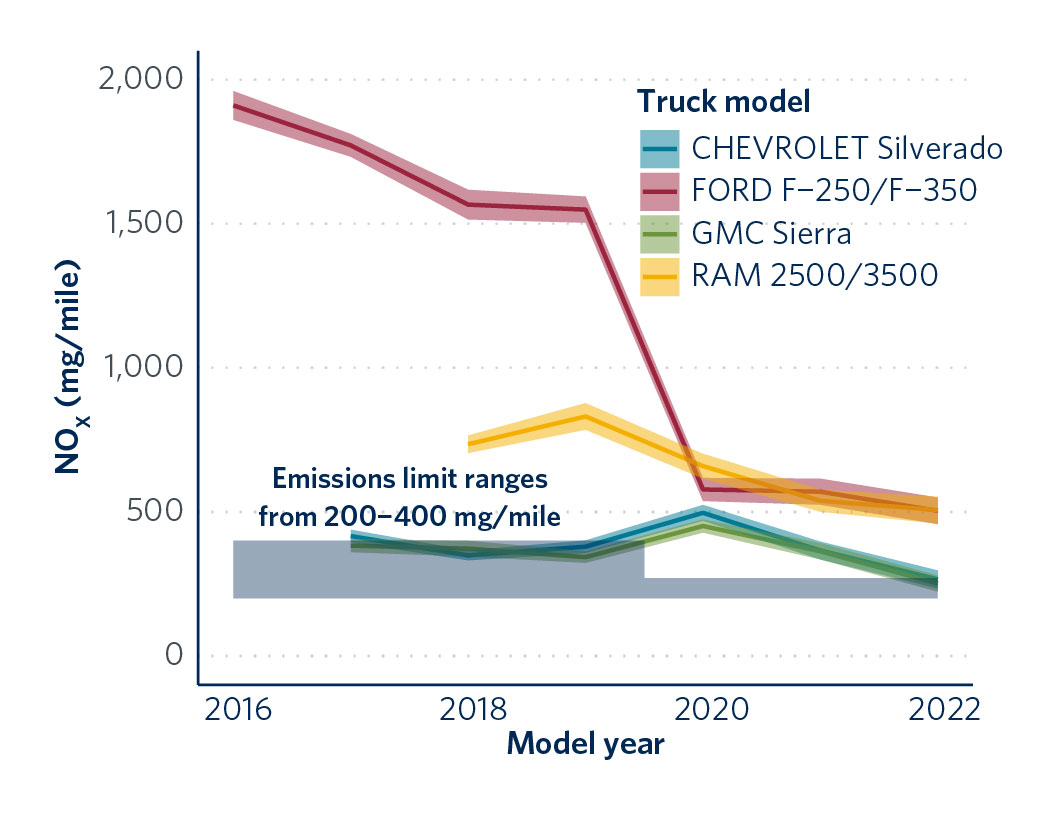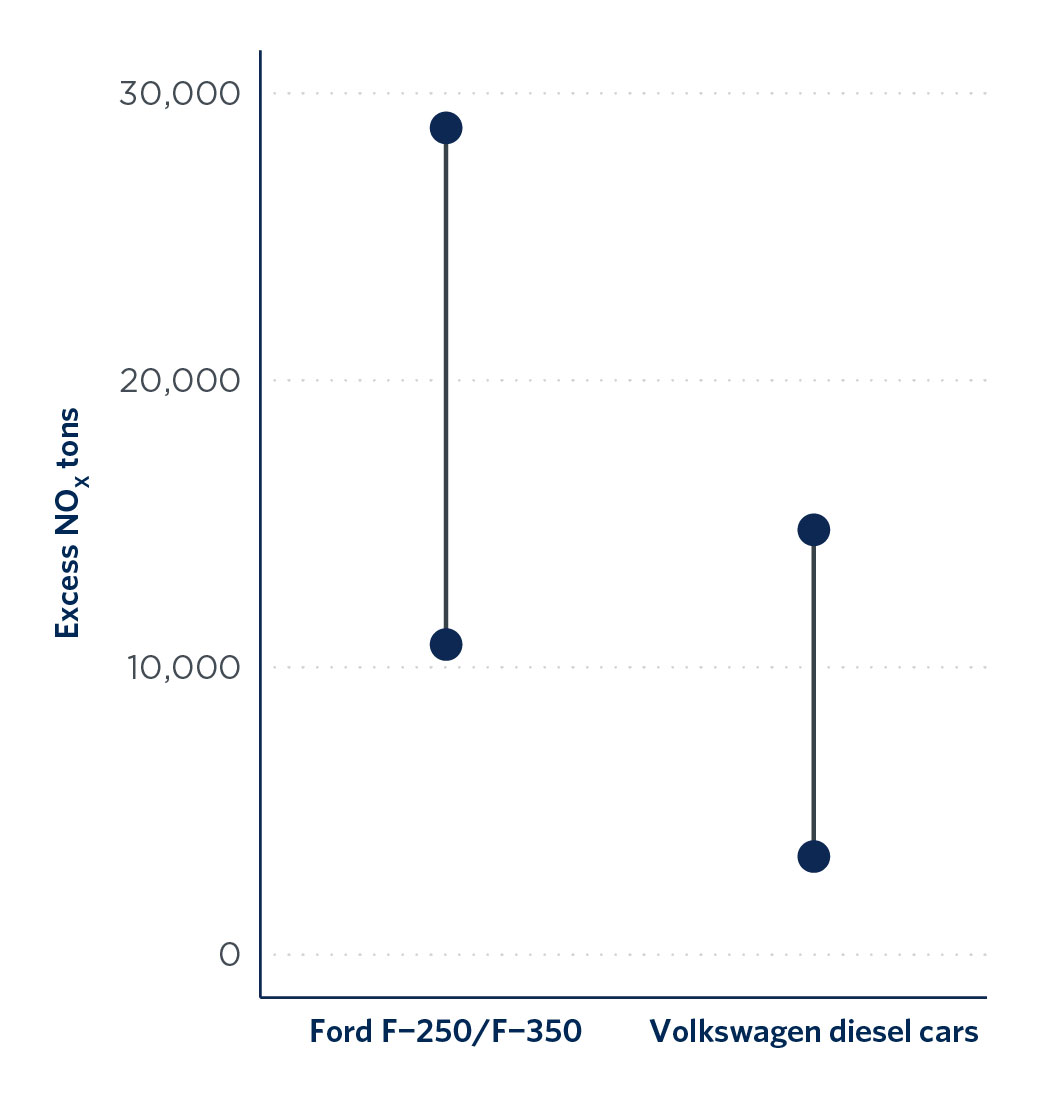Ford diesel pickup trucks are the highest NOx emitter of its kind on U.S. roads, says new TRUE case study

New analysis under the TRUE North American database shows Ford F-250/350 trucks from model years 2010-2019 measured in real-world conditions emitting 3 to 10 times more NOx emissions than standard limits.
The latest case study under the TRUE North American database analyzes the real-world emissions of diesel pickup trucks on the road in the United States today. With updated data collected by the Virginia Department of Environmental Quality and the Colorado Department of Public Health and Environment, new analysis from TRUE partner the International Council on Clean Transportation (ICCT), offers a larger snapshot of real-world vehicle emissions from data between 2015–2023.
Similar to observations from 2020, which analyzed data from years 2010–2018, this new report found that Ford F-250 and Ford F-350 trucks of model years (MY) 2013–2019 produce the highest real-world nitrogen oxide (NOx) emissions among trucks of similar size, including models such as the Ram 2500/3500s, GMC Sierra, and Chevrolet Silverado.

Despite being the subject of last year’s $1.6 billion settlement between the engine manufacturer Cummins and the U.S. Department of Justice and California, RAM 2500/3500 trucks of MY 2013-2019 are not the highest emitting diesel truck model captured by road-side instruments in Colorado and Virginia. In fact, Ford diesel pick-up trucks of MY 2017-2019 emitted roughly 2 times higher NOx emissions than Ram trucks, and nearly 4 times higher emissions than GMC and Chevrolet.
Across the four truck manufacturers, Ford diesel trucks of MY 2016–2019 were the only truck certified to an interim bin of Tier 3 light-duty emission standards under the U.S. Environmental Protection Agency, meaning they were not required to certify to the Supplemental Federal Test Procedures. These trucks presented emissions 3 to 4 times higher than the limits under real-world conditions.

This new analysis also found that the Ford F-250/350 models were particularly susceptible to changes in temperature. At 30–40°F, average emissions emitted by Ford trucks were roughly 2 times higher than emissions at the warmest measured temperatures, and 3.5 times higher at even colder temperatures between 20-30°F. Other models show little variation in emissions at cold ambient temperatures, signaling technology exists to improve emission controls at ambient temperatures.
High real-world emissions exceeding laboratory limits may have several causes. Nearing ten years old, these vehicles are subject to routine deterioration. Individual vehicle malfunctions, tampering with emission control systems, and auxiliary emission control device (AECD) could be other causes. When disclosed and approved by authorities, AECDs are legal, whereas undisclosed and unapproved AECDs are known as “defeat devices.”

"The scale of excess emissions from these Ford trucks is significant," said Drew Kodjak, executive director of the ICCT, a TRUE partner. "There are an estimated 850,000–1,340,000 of these vehicles on U.S. roads today, contributing up to 28,800 metric tons of excess NOx emissions annually. NOx is a key contributor to outdoor air pollution in the forms of ground-level ozone and secondary fine particulate matter (PM2.5). Long-term exposure to these pollutants is linked to a range of adverse health outcomes, including disability and years of life lost due to stroke, ischemic heart disease, chronic obstructive pulmonary disease, and lung cancer—particularly in sensitive populations.”
This range well exceeds the excess NOx emissions from Volkswagen’s diesel passenger cars found to contain defeat devices in 2015, which was the subject of the commonly referred to “Dieselgate” scandal and the impetus for the founding of the TRUE Initiative.
Sheila Watson, deputy director of the FIA Foundation, a TRUE partner and core founder, adds, “Time and again, TRUE research demonstrates that laboratory testing alone isn't enough. These findings show why robust, independent emissions testing programs are absolutely essential to understand the impact of vehicles on the road and hold manufacturers to account. Without real-world monitoring, these excess emissions would continue unchecked, impacting air quality and public health.”



